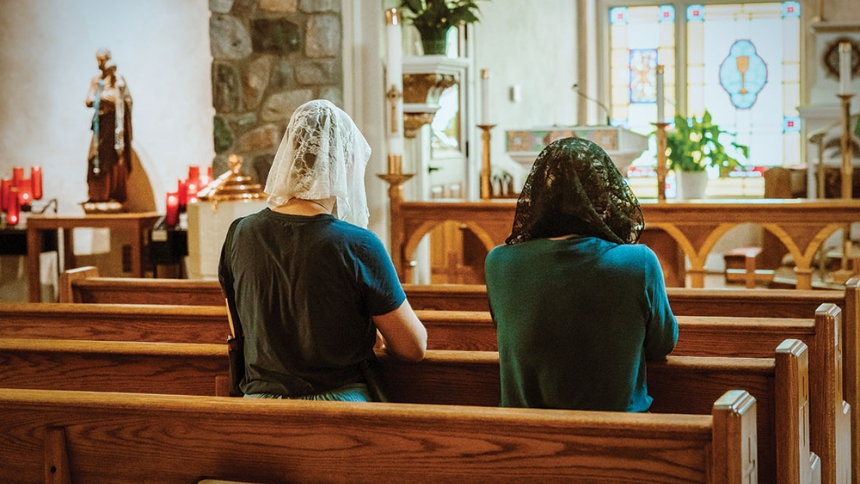
In recent years, there seems to be a growing number of women veiling at Holy Mass across the Diocese of Lansing. Why? Writer Kathryn Mietelka of the Diocese of Lansing's FAITH Magazine has met with one mother-daughter couple to find out. Kathryn writes:
Mother and daughter duo Mary and Kathleen Kossey, Adrian residents and lifelong Catholics, don their lacy mantillas before silently entering the church and blessing themselves with holy water.
This ritual is one they’ve repeated for many years, every time they enter a church — never entering without some form of dignified head covering, Kathleen Kossey says.
Women’s head coverings largely disappeared for Roman Catholics after the Second Vatican Council. But some women, like the Kosseys, are choosing to bring them back.
Before the 1970s, head coverings were required for women during Mass, just as men were required to remove their hats out of reverence for Christ. This devotion, commonly known as veiling, is encouraged by St. Paul and taken for granted by early Church Fathers.
“I grew up with the long veil,” says Mary Kossey, 68. “I’d always known that. That was our tradition.”
But following the Second Vatican Council, Kossey remembers changes to the types of head coverings and the Mass itself.
Finally, in the 1976 declaration Inter Insigniores addressing the question of women and the priesthood, a statement was made that veils “no longer have a normative value.”
And with that, the practice was dropped.
“In my case, I’m the second oldest of nine children, and we did not grow up wearing a veil,” says Kathleen Kossey. “I’d never even heard about it or known of it until I was probably in my 20s, when I was discerning a religious vocation.”
Her mother vividly remembers the time when this requirement fell out of use. “I was a teenager when we stopped wearing head covering,” she says. “I got away from it because nobody else did it anymore, and I didn’t want to be the odd man out.”
More than 50 years later, most female heads in the pews remain uncovered — something they are now free to choose. But the practice of veiling is far from obsolete, as women of all ages are electing to wear them — with many reasons of their own.
After her daughter adopted the practice of veiling as a young adult, Mary Kossey decided to return to the custom of her youth. Now, she can’t imagine it any other way. “I want to veil because Jesus in the Eucharist is my king, and that’s my sign of respect for him.”
Other women from around the diocese chime in with their reasons, too. “I’m not sure if other people wear one for the same reason, [but] I wear a veil at Mass because it reminds me that Christ loves me like a bride, especially in the Eucharist,” says Marie Kryst of Grass Lake. “I read somewhere to meditate on receiving Christ like your bridegroom as you walk down the aisle to receive him in the Eucharist, and it only feels right to wear a veil knowing the reality of that moment.”
Gina Borrelli of Manitou Beach says, “I choose to veil for Mass because it's not only a beautiful reminder that God loves me and should act as such, but it also helps me grow in humility, especially as I approach the altar to receive Jesus in the Eucharist.”
But in the end, it all comes down to one simple reason. “Our actions reflect what we believe, and what we believe influences our actions,” Kathleen Kossey explains, adding that one of her reasons for veiling is that it also impacts her interior life.
These personal convictions all have roots in the rich tradition of the Church. Historically, what is sacred has always been veiled, including the tabernacle and chalice used on the altar.
Properly understood, the veiling of a woman points to her own sacredness and an image of Our Lady and the Church, the bride of Christ.
Finally, since woman was created last, she is thus the high point of creation, and so veiling in the presence of Christ is seen as a sign of humility in her creator’s presence.
But when asked about women who may not share this conviction, Kathleen Kossey quickly adds a cautionary warning. “Don’t let whether you veil or not veil be a reason to avoid going before the Lord," she says. "Don’t let that stop you." She adds that it’s against the virtue of charity to judge another person for choosing to veil or not.
And for those experiencing a spark of interest in this ancient devotion? “Take your interest, questions, and prayer before St. Joseph and Our Lady first,” says Kathleen Kossey. “Seek the Lord and you shall find him.”
